- About
- Advocacy
- Certification
- Events
- Technical Resources
- Standards Development
- Store
WDMA Store: Architectural Door StandardsANSI/WDMA I.S. 1A-21 Interior Architectural Wood Flush DoorsShow Details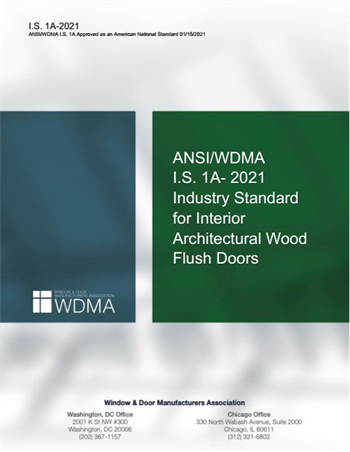 ANSI/WDMA I.S.1A-21 -Industry Standard for Interior Architectural Wood Flush Doors is a general industry standard that establishes expectations for the performance and aesthetic attributes of architectural wood flush doors. The architectural wood flush door standard is a voluntary industry standard based upon generally accepted industry practices used to provide guidance to architects, designers and specifiers to clearly identify the aesthetic and structural performance of an interior wood flush door for a particular opening. This standard describes the various functions and performance levels that attributed based upon the flush wood door construction. Furthermore, the standard describes the manner in which aesthetics are primarily controlled by the species, veneer cut, matching of veneers and finish selected, or by the laminate selected. The purpose of this publication is to:
This Standard applies to architectural wood flush doors intended for interior application only. This edition includes all Errata as of July 2022. Price: $30.00 PurchaseANSI/WDMA I.S. 6A-21 Interior Architectural Stile and Rail DoorsShow Details ANSI/WDMA I.S.6A-21 -Industry Standard for Interior Architectural Wood Stile and Rail Doors is a general industry standard that establishes expectations for the performance and aesthetic attributes of architectural wood stile and rail doors. The architectural wood stile and rail door standard is a voluntary industry standard based upon generally accepted industry practices used to provide guidance to architects, designers and specifiers to clearly identify the aesthetic and structural performance of an interior wood stile and rail door for a particular opening. This standard describes the various functions and performance levels that attributed based upon the stile and rail wood door construction. Furthermore, the standard describes the manner in which aesthetics are primarily controlled by the species, veneer cut, matching of veneers and finish selected, or by the laminate selected. The purpose of this publication is to:
This Standard applies to architectural wood flush doors intended for interior application only. This edition includes all Errata as of July 2022. Price: $30.00 PurchaseANSI/WDMA I.S. 1A-13 Interior Architectural Wood Flush DoorsShow Details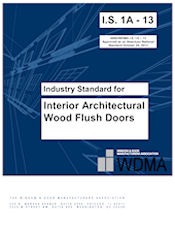 ANSI/WDMA I.S.1A-13 -Industry Standard for Interior Architectural Wood Flush Doors is a general industry standard that establishes expectations for the performance and aesthetic attributes of architectural wood flush doors. These combine in producing a wood flush door for a particular opening. Function and performance are primarily controlled by the wood door construction. Aesthetics are primarily controlled by species, veneer cut, matching of veneers and finish selected, or by the laminate selected. WDMA standards require the designation of a performance duty level in addition to an aesthetic grade. Performance duty levels are based on the amount and severity of use. There are three levels of duty based on performance values of eight different attributes as defined in the Section P. It is the responsibility of the specifier to select the duty level for each application. The purpose of this publication is to: Define the aesthetic grades and performance duty levels of architectural wood flush doors available through this standard. Provide general information, standards, and tests that will ensure all products complying with this standard can be evaluated on an equal basis. Provide a logical, simple system of references, keyed to guide specifications, which will enable the architect to specify wood flush doors thoroughly, precisely, and accurately. Provide information necessary for the specifier to identify products and by which products are to be evaluated. This Standard applies to architectural wood flush doors intended for interior application. Doors specified to meet this standard are not recommended for exterior use. Once purchased, you will receive an electronic version of the document. Price: $30.00 PurchaseANSI/WDMA I.S. 6A-13 Interior Architectural Stile and Rail DoorsShow Details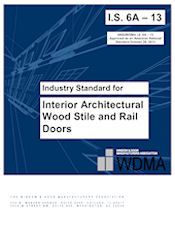 ANSI/WDMA I.S.6A-13 Industry Standard for Architectural Stile and Rail Doors is a general industry standard that establishes expectations for the performance and aesthetics of architectural wood stile & rail doors. These combine in producing a wood stile and rail door for a particular opening. Function and performance are primarily controlled by the wood door construction. Aesthetics are primarily controlled by species, veneer cut, matching of veneers and finish selected. WDMA standards require the designation of a performance duty level in addition to an aesthetic grade. Performance duty levels are based on the amount and severity of use. There are three levels of duty based on performance values of eight different attributes as defined in Section P. It is the responsibility of the specifier to select the duty level for each application. Define the aesthetic grades and performance duty levels of architectural wood stile and rail doors available through this standard. Provide general information, standards, and tests that will ensure all products complying with this standard can be evaluated on an equal basis. Provide a logical, simple system of references, keyed to guide specifications, which will enable the architect to specify wood stile and rail doors thoroughly, precisely, and accurately. Provide information necessary for the specifier to identify products and by which products are to be evaluated. This standard applies to architectural wood stile and rail doors intended for interior application. Doors specified to meet this standard are not recommended for exterior use. Once purchased, you will receive an electronic version of the document. Price: $30.00 PurchaseWDMA T.M. 6-23 Adhesive DurabilityShow Details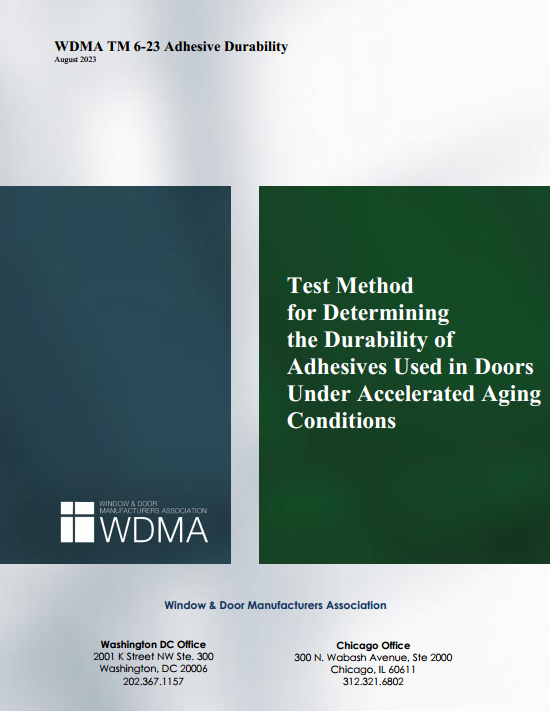 WDMA T.M. 6-23 Test Method for Determining the Durability of Adhesives Used in Doors under Accelerated Aging Conditions establishes standard methods to determine the durability of adhesive bonds between plies of wood by exposing test specimens to cyclic conditions of extremes in temperature and humidity. The durability of these bonds is crucial to the performance of the door in the field. This standard will not determine the useful age of doors in service as a result of the data obtained during this test, it will, however, indicate what the effects of extreme temperature and humidity will have on the performance of the adhesives used in constructing doors. These test methods provide testing, measurement, and inspection criteria using common species of lumber and veneer used in the construction of wood flush doors. Requirements are given for Type I (exterior) and Type II (interior) adhesive bond tests. Provisions are made for identifying construction and type of adhesive bond of doors which fully comply with this standard. Once purchased, you will receive an electronic version of the document. Price: $11.00 PurchaseWDMA T.M. 7-23 Cycle-Slam TestShow Details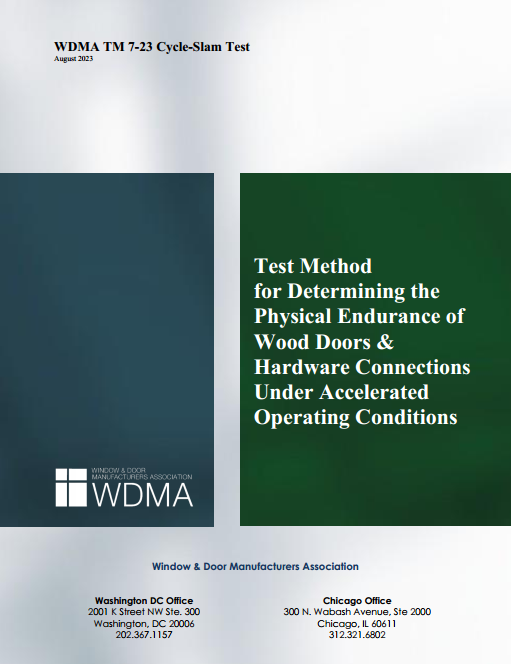 WDMA T.M. 7-23 Test Method for Determining the Physical Endurance of Wood Doors & Hardware Connections under Accelerated Operating Conditions tests the performance of a wood door as it swings in its opening. The test is designed to accelerate the actual operating conditions. This test method will not determine the useful life of doors in service as a result of the data obtained during this test. It will however, indicate what the effects of hard impacts upon closing (slamming) and cycling will be on the door and door hardware connections. It will provide useful data for designers, specifiers, and manufacturers in making judgments on the ability of the door assembly to maintain serviceability under actual operating conditions. Once purchased, you will receive an electronic version of the document. Price: $11.00 PurchaseWDMA T.M. 8-23 Hinge Loading TestShow Details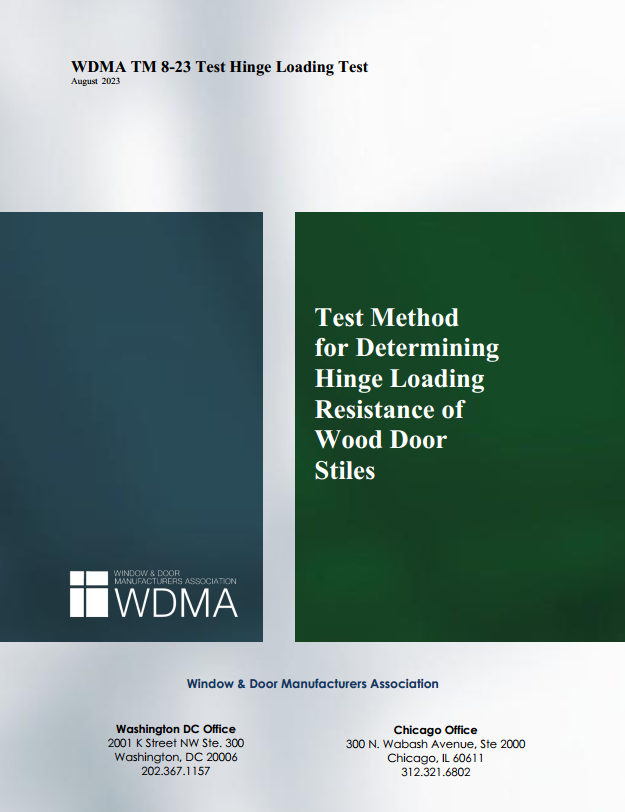 WDMA T.M. 8-23 Test Method for Determining Hinge Loading Resistance of Wood Door Stiles determines the ability of a wood door stile to resist the horizontal withdrawal of an attached hinge. This small-scale test is designed to simulate the application of a downward force to the knob area on the leading edge of a hinged swinging door. Recent updates to this TM include revisions/corrections to the diagram to add further clarification. Also, a recommended test report form was added. Once purchased, you will receive an electronic version of the document. Price: $7.00 PurchaseWDMA T.M. 10-23 Screw Holding CapacityShow Details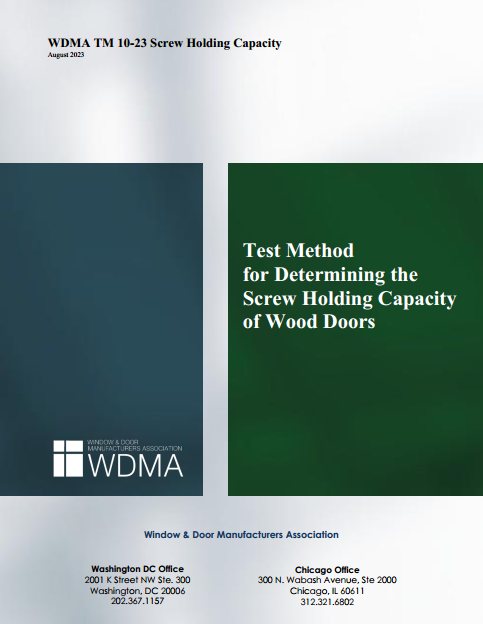 WDMA T.M. 10-23 Test Method for Determining the Screw Holding Capacity of Wood Doors determines the ability of a wood door stile to resist the withdrawal of a screw perpendicular to the stile edge. More detail was added to Section 5, Test Specimen; Vertical Edge Samples, Horizontal Edge Samples, and Face Samples. Also, revisions/corrections to the diagram to add further clarification and a recommended test report form were added. Once purchased, you will receive an electronic version of the document. Price: $7.00 PurchaseWDMA T.M. 15-23 Vertical Edge Impact TestShow Details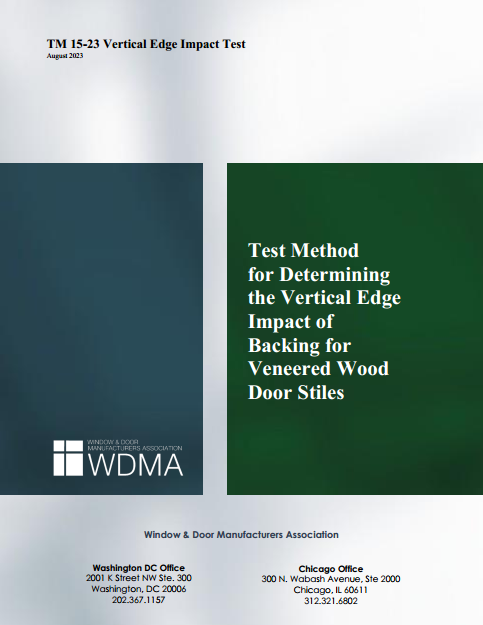 WDMA T.M. 15-23, Test Method for Determining the Vertical Edge Impact of Backing for Veneered Wood Door Stiles determines the ability of a backer material for veneered wood door stiles to resist impact along its vertical corner edge. This is a small-scale test, using a falling weight to impart an impact load to the edge of a sample. The depth of the depression created by the impact is constitutes the pass/fail criteria. Once purchased, you will receive an electronic version of the document. Price: $7.00 PurchaseHow To Store, Handle, Finish, Install and Maintain Wood DoorsShow Details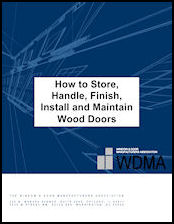 Helpful information related to basic handling of wood doors and how to insure that they continue to look good and operate properly in the future. Once purchased, you will receive an electronic version of the document. Price: $5.00 Purchase |
Quick Links
2001 K Street NW, 3rd Floor North, Washington, D.C. 20006
Phone: 202.367.1157
© Copyright 2021. All rights reserved.





